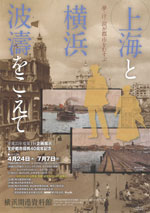Main content starts here.
40 Years of Friendship
Last updated date:2018/9/28
40 Years of Friendship

Commemorating the 40th anniversary of friendship city ties between Shanghai and Yokohama, the Yokohama Archives of History is currently holding a special exhibition on the cities at a time when Asian ports were opening to the rest of the world titled “Shanghai and Yokohama, Beyond the Rolling Seas”. The Port of Shanghai was opened in 1843. Sixteen years later, in 1859, the Port of Yokohama followed suit. The two cities rapidly developed as hubs for commerce with other countries – “Nippon Yusen Kaisha” and “Peninsular and Oriental Steam Navigation Company” had even secured maritime corridors as early as that moment in time – and of course commerce with each other. And that is the relation the exhibition mainly explores.
Leading to the exhibition hall are comparative pictures of Shanghai and Yokohama as they were at the time and as they are now. Besides the many historical pictures and documents, the exhibition offers some bigger pieces such as a wooden piano near the entrance or a red Chinese dress facing it. If you don’t read Japanese, I suggest going with a Japanese friend to better understand what you’re seeing.
For example, the S. Chew piano – one of only 12 remaining in the world – was made in Yokohama’s Chinatown by 1st generation immigrant Mr. Shosei Chew (Zhou in Chinese, pronounced ‘shoo’). Born in the Zhenhai district in the Province of Zhejiang, China, he polished his skills in Shanghai under a British piano company before moving to Japan in 1905, where he became shop supervisor for a different firm. In 1912, he opened his own company in Yokohama Chinatown. His son succeeded to the business after his father died in the Great Kanto Earthquake of 1923. Their piano factory in what is now Minami Ward kept running until it was lost to air raids in 1945. In recent years, twelve “S. Chew” pianos (made by Chew senior) and six “S. Chew & Sons” pianos (made by Chew junior) have resurfaced here and there for a total of 18 pianos.
The Chinese dress is interesting for it is made from polyester. If you’re anything like me, when you think of Chinese dresses, you think silk. But in the 1920s, polyester was a much newer and rarer, hence more sought after, material. (A side note for Japanese learners: Look for the importers’ balance books in the exhibition. It was my first time to see the kanji compound for polyester!)
At the time, the Chinese population in Yokohama was famous mainly for 2 items: western clothes (because there was previously no way to make them in Japan) and pianos. Thanks in part to this, Yokohama rapidly attracted a large population of craftsmen rather than workers as is the case in countries like Canada and the U.S. where Chinese immigrants often had to take on labors such as building railways. And probably because most shops were aimed at foreigners, most signage in the pictures on display was in English. I was very surprised to see this, since now almost none can be seen.
Among the hundreds of old tools, pieces of clothing, documents, pictures and maps, the exhibition counts old labels from a silk trading company from Yokohama. The marketing put into them is quite remarkable, with images tailored to each country where they did business. There are also many treasures of literature such as a book on Shanghai written by none other than Eliza Scidmore (of the cherry blossoms fame) as well as Hepburn’s very first Japanese-English dictionary printed in Yokohama. There is also a part dedicated to Ginko Kishida, a journalist and businessman of the Meiji era. On top of editing the Hepburn dictionary, he is famous for publishing the very first newspaper in Japan as well as manufacturing eye drops. He was mainly active in Yokohama and Shanghai.
As for a living heritage of the history between the 2 cities, look no further than Tomsung & Co. on Honcho-dori, just a few steps from the venue of the exhibition. Originating from Ningbo city in the Province of Zhejiang, this Chinese tailor has been operating in Yokohama since the end of the Meiji era. His hometown is said to be the birthplace of “Shanghai tailors”. Not only has the place been there forever, it has been passed down strictly within the family and so the traditional techniques and skills learned over generations are still alive today. I have had the pleasure of meeting the man when I went in for adjustments on a suit. At the time, I didn’t know his business had such a long history. One this is for sure, his skills are outstanding.
You can catch the exhibition at the Yokohama Archives of History(外部サイト).
Shanghai and Yokohama, Beyond the Rolling Seas
Note: This exhibition is over.
Dates: April 24 – July 7, 2013
Time: 9:30 a.m. – 5 p.m.
Entrance fee: Adult – 200 yen; Middle school student and younger – 100 yen
Address: 3, Nihon Odori NakaWard, Yokohama 231-0021
Note: This exhibition concluded in July 2013. However, I still suggest visiting the permanent and current special exhibitions at the Yokohama Archives of History(外部サイト).
Page ID:432-923-415

